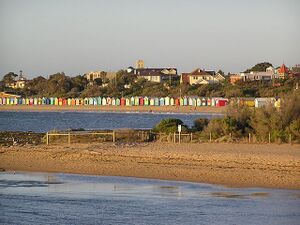
 Landmark court win upholds protection for Gliders and Victoria’s forests, eastgippsland.net.au (Jun 27, 2023)
Landmark court win upholds protection for Gliders and Victoria’s forests, eastgippsland.net.au (Jun 27, 2023)
Networks and sustainability initiatives[edit | edit source]
- Live.org.au, Locals Into Victoria's Environment
- Mount Alexander Sustainability Group Inc.
Climate action[edit | edit source]
Lighter Footprints, local Climate Action Group
Biodiversity[edit | edit source]
- Nature Glenelg Trust, "mission-driven, not-for-profit organisation that believes in positive action, and working with the community and our partners to achieve real results on the ground."
Open spaces[edit | edit source]
South Surrey Park, site maintained by Friends of South Surrey Park, (Greenlivingpedia)
Wikipedia: Protected areas of Victoria: Victoria is the smallest mainland state in Australia. As of 2008 it contained 2,850 separate protected areas with a total land area of 39,273 square kilometres (15,163 sq mi) (17.26% of the state's area). Of these, 45 were national parks, totalling 28,023 square kilometres (10,820 sq mi) (11.32% of the state's area)
Trees, woodland and forest[edit | edit source]
- Environment East Gippsland, "longest running community forest group working for the protection of Victoria’s last and largest area of ancient forest and connected natural environments and wildlife."
Community energy[edit | edit source]
Community Energy, information from Victoria State government, includes a "Guide to Community-Owned Renewable Energy for Victorians"
Maps: Wind energy in Victoria, 2010
Cycling activism[edit | edit source]
Wikipedia: Cycling in Victoria
News and comment[edit | edit source]
2021
It takes a village: An alternative social media platform seeks to end the epidemic of loneliness and isolation, Jan 28[1]
2017
Monash to become Australia's first 100 per cent renewable energy powered university, Oct 9[2]
Victoria backs renewable energy community hubs with $900,000 investment, Apr 28[3]
2014
Yarra City Council Becomes Australia's 1st 'One Planet Council', September 3[4]
About Victoria (Australia)[edit | edit source]
Victoria (commonly abbreviated as Vic) is a state in southeastern Australia. It is the second-smallest state (after Tasmania), with a land area of 227,444 km2 (87,817 sq mi); the second-most-populated state (after New South Wales), with a population of over 6.7 million; and the most densely populated state in Australia (29.5 per km2). Victoria is bordered by New South Wales to the north and South Australia to the west and is bounded by the Bass Strait to the south (with the exception of a small land border with Tasmania located along Boundary Islet), the Great Australian Bight portion of the Southern Ocean to the southwest, and the Tasman Sea (a marginal sea of the South Pacific Ocean) to the southeast. The state encompasses a range of climates and geographical features from its temperate coastal and central regions to the Victorian Alps in the northeast and the semi-arid northwest.
The majority of the Victorian population is concentrated in the central-south area surrounding Port Phillip, and in particular within the metropolitan area of Greater Melbourne, Victoria's state capital and largest city and also Australia's second-largest city, where over three-quarters of the Victorian population live. The state is home to four of Australia's 20 largest cities: Melbourne, Geelong, Ballarat and Bendigo. The population is culturally diverse, with 35.1% of inhabitants being immigrants.
Near you[edit | edit source]
External links
- Wikipedia: Aurora, Victoria
- Central Victorian Greenhouse Alliance
- Sustainability Victoria, Victorian government statutory authority which delivers programs on integrated waste management and resource efficiency
- Environment, information from Yarra Council
References
- ↑ @shareable
- ↑ monash.edu
- ↑ ecogeneration.com.au
- ↑ BioRegional Australia

